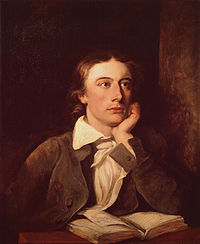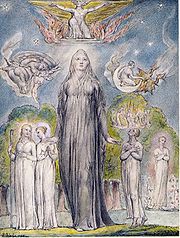
Ode on Melancholy
Encyclopedia

John Keats
John Keats was an English Romantic poet. Along with Lord Byron and Percy Bysshe Shelley, he was one of the key figures in the second generation of the Romantic movement, despite the fact that his work had been in publication for only four years before his death.Although his poems were not...
in the spring of 1819. In the spring of that year, Keats wrote the poem along with "Ode on a Grecian Urn
Ode on a Grecian Urn
"Ode on a Grecian Urn" is a poem written by the English Romantic poet John Keats in May 1819 and published in January 1820 . It is one of his "Great Odes of 1819", which include "Ode on Indolence", "Ode on Melancholy", "Ode to a Nightingale", and "Ode to Psyche"...
", "Ode to a Nightingale
Ode to a Nightingale
"Ode to a Nightingale" is a poem by John Keats written in May 1819 in either the garden of the Spaniards Inn, Hampstead, or, as according to Keats' friend Charles Armitage Brown, under a plum tree in the garden of Keats House, Hampstead, London. According to Brown, a nightingale had built its nest...
", "Ode on Indolence
Ode on Indolence
The "Ode on Indolence" is one of five odes composed by English poet John Keats in the spring of 1819. The others were "Ode on a Grecian Urn", "Ode on Melancholy", "Ode to a Nightingale" and "Ode to Psyche"...
", and "Ode to Psyche
Ode to Psyche
"Ode to Psyche" is a poem by John Keats written in spring 1819. The poem is the first of his 1819 odes, which include "Ode on a Grecian Urn" and "Ode to a Nightingale". "Ode to Psyche" is an experiment in the ode genre, and Keats's attempt at an expanded version of the sonnet format that describes...
". In the Autumn of that year, Keats wrote "To Autumn
To Autumn
"To Autumn" is a poem by English Romantic poet John Keats . The work was composed on 19 September 1819 and published in 1820 in a volume of Keats's poetry that included Lamia and The Eve of Saint Agnes. "To Autumn" is the final work in a group of poems known as Keats's "1819 odes"...
", which completed his Great Odes of 1819
John Keats's 1819 odes
In 1819, John Keats composed six odes in a short period of time that have become some of his most famous poems. They are united and ordered as a set by various critics to form a greater truth, each depending on the original order...
. The narrative of the poem describes the poet’s perception of melancholy through a lyric
Lyric poetry
Lyric poetry is a genre of poetry that expresses personal and emotional feelings. In the ancient world, lyric poems were those which were sung to the lyre. Lyric poems do not have to rhyme, and today do not need to be set to music or a beat...
discourse between the poet and the reader along with the introduction to Ancient Grecian characters and ideals.
Background
While studying at Enfield, Keats attempted to gain a knowledge of Grecian art from translations of Tooke’s Pantheon, Lempriere's Classical Dictionary and Spence's Polymetis. Although Keats attempted to learn Ancient GreekAncient Greek
Ancient Greek is the stage of the Greek language in the periods spanning the times c. 9th–6th centuries BC, , c. 5th–4th centuries BC , and the c. 3rd century BC – 6th century AD of ancient Greece and the ancient world; being predated in the 2nd millennium BC by Mycenaean Greek...
, the majority of his understanding of Grecian mythology
Greek mythology
Greek mythology is the body of myths and legends belonging to the ancient Greeks, concerning their gods and heroes, the nature of the world, and the origins and significance of their own cult and ritual practices. They were a part of religion in ancient Greece...
came from the translations into English. "Ode on Melancholy" contains references to classical themes, characters, and places such as Psyche, Lethe
Lethe
In Greek mythology, Lethe was one of the five rivers of Hades. Also known as the Ameles potamos , the Lethe flowed around the cave of Hypnos and through the Underworld, where all those who drank from it experienced complete forgetfulness...
, and Prosperine
Proserpina
Proserpina or Proserpine is an ancient Roman goddess whose story is the basis of a myth of Springtime. Her Greek goddess' equivalent is Persephone. The probable origin of her name comes from the Latin, "proserpere" or "to emerge," in respect to the growing of grain...
in its description of melancholy, as allusions to Grecian art and literature were common among the “five great odes”.
Unlike the narrator in "Ode to a Grecian Urn", "Ode to a Nightingale
Ode to a Nightingale
"Ode to a Nightingale" is a poem by John Keats written in May 1819 in either the garden of the Spaniards Inn, Hampstead, or, as according to Keats' friend Charles Armitage Brown, under a plum tree in the garden of Keats House, Hampstead, London. According to Brown, a nightingale had built its nest...
", and "Ode to Psyche
Ode to Psyche
"Ode to Psyche" is a poem by John Keats written in spring 1819. The poem is the first of his 1819 odes, which include "Ode on a Grecian Urn" and "Ode to a Nightingale". "Ode to Psyche" is an experiment in the ode genre, and Keats's attempt at an expanded version of the sonnet format that describes...
", the narrator of "Ode on Melancholy" speaks directly to the reader rather than to an object or an emotion. With only three stanzas, the poem is the shortest of the odes Keats wrote in 1819; however, the original first stanza of the poem was removed before the poem’s publication in 1820. According to Harold Bloom
Harold Bloom
Harold Bloom is an American writer and literary critic, and is Sterling Professor of Humanities at Yale University. He is known for his defense of 19th-century Romantic poets, his unique and controversial theories of poetic influence, and his prodigious literary output, particularly for a literary...
, one can presume that the “harmony was threatened if fully half of [the poem] was concerned with the useless quest after “The Melancholy”. Despite its adjusted length, Keats thought the poem to be of a higher quality than "Ode on Indolence
Ode on Indolence
The "Ode on Indolence" is one of five odes composed by English poet John Keats in the spring of 1819. The others were "Ode on a Grecian Urn", "Ode on Melancholy", "Ode to a Nightingale" and "Ode to Psyche"...
", which was not published until 1848, after Keats’s death.
Structure
"Ode on Melancholy" consists of three stanzas with ten lines each. Because the poem has fewer stanzas than "Ode on Indolence" and "Ode on a Grecian Urn", the rhyme schemeRhyme scheme
A rhyme scheme is the pattern of rhyme between lines of a poem or song. It is usually referred to by using letters to indicate which lines rhyme. In other words, it is the pattern of end rhymes or lines...
appears less elaborate, with the first and second stanzas sharing a rhyme scheme of: ABABCDECDE, while the third takes on one of its own: ABABCDEDCE. As with "Ode on a Grecian Urn", "Ode on Indolence", and "To Autumn", each stanza begins with an ABAB rhyme scheme then finishes with a Miltonic sestet. The general meter of the poem is iambic pentameter
Iambic pentameter
Iambic pentameter is a commonly used metrical line in traditional verse and verse drama. The term describes the particular rhythm that the words establish in that line. That rhythm is measured in small groups of syllables; these small groups of syllables are called "feet"...
.
Themes and critical responses

Negative capability
Negative Capability
Negative capability is the ability to perceive and to think more than any presupposition of human nature allows. It describes the capacity of human beings to reject the totalizing constraints of a closed context, and to both experience phenomenon free from any epistemological bounds as well as to...
appears subtly in "Ode on Melancholy" according to Harold Bloom, who describes the negatives in the poem as being the result of a carefully crafted ironies that first become truly evident as the poet describes the onset of melancholy through an allegorical image of April rains supplying life to flowers. The use of the “droop-headed flowers” (line 13) to describe the onset of an ill-temper, according to Bloom, represents a "passionate" attempt by the poet to describe the proper reaction to melancholy. In the original first stanza, the “Gothicizing” of the ideal of melancholy strikes Bloom as more ironical and humorous, but with the removal of that text, the image of the “droop-headed flowers” loses the irony it would otherwise contain, and in doing so subverts the negative capability
Negative Capability
Negative capability is the ability to perceive and to think more than any presupposition of human nature allows. It describes the capacity of human beings to reject the totalizing constraints of a closed context, and to both experience phenomenon free from any epistemological bounds as well as to...
seen in "Ode to a Nightingale", yet Bloom states that the true negativity becomes clear in the final stanza's discussion of Beauty. The final stanza begins:
- She dwells with Beauty-- Beauty that must die (line 21)
which he suggests supplies the ultimate case of a negative relationship because it suggests that the only true beauty is one that will die. But Thomas McFarland, while acknowledging the importance of the original first stanza to Keats's endeavor, openly praises the removal of the lines as an act of what he calls "compression". McFarland believes that the poem's strength lies in its ability to avoid the "Seemingly endless wordage of "Endymion
Endymion (poem)
Endymion is a poem by John Keats first published in 1818. Beginning famously with the line "A thing of beauty is a joy for ever", Endymion, like many epic poems in English , is written in rhyming couplets in iambic pentameter...
" and lets the final stanza push the main themes on its own. By removing unnecessary information such as the reason the poet suggests the trip to Lethe, Keats allows the reader to avoid the "fancy" aspects that would have appeared in the first line and were not sustained throughout the rest of the text.
Sexuality
Although the poem contains no overt sexual references, allegations of a hidden sexuality in the poem’s text appear in Christopher John Murray’s ‘’Encyclopedia of the Romantic Era.’’ Murray suggests that the poem instructs the reader to approach melancholy in a manner that will result in the most pleasurable outcome for the reader. The words “burst Joy’s Grape” in line 28 lead Daniel Brass to state:The height of the joy, the moment when the world can improve no further, is both the end of joy and the beginning of melancholy. A climax implies a dénouement, and ‘bursting Joy’s grape’ involves both the experience of ultimate satisfaction, with the powerful image of the juice bursting forth from a burst grape, and the beginning of a decline.In The Masks of Keats, Thomas McFarland suggests that Keats's beautiful words and images attempt to combine the non-beautiful subject of melancholy with the beauty inherent in the form of the ode. He too writes that the images of the bursting grape and the "globèd peonies" show an intention by the poet to bring the subject of sexuality into the discussion on melancholy.

